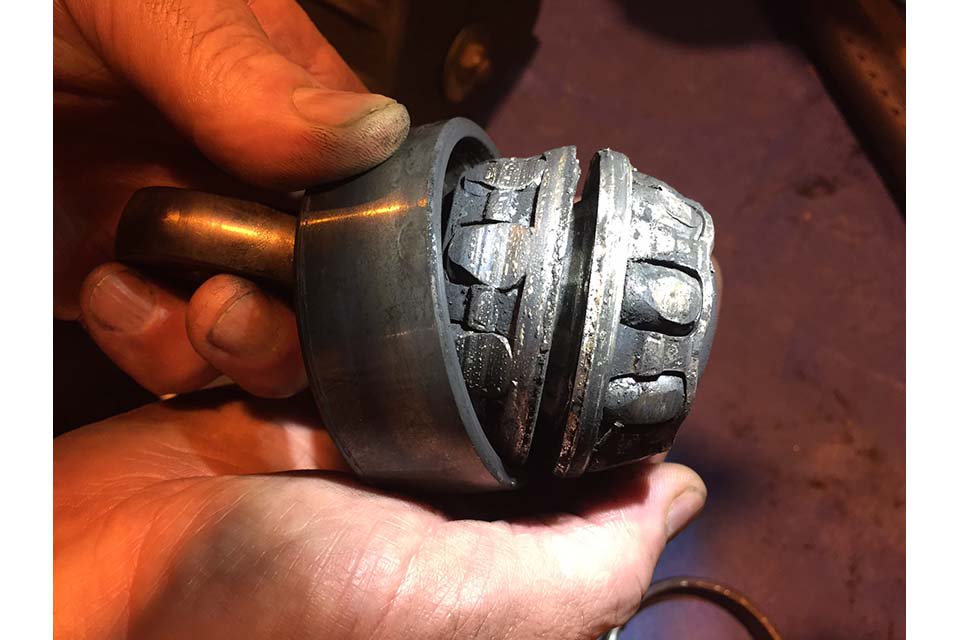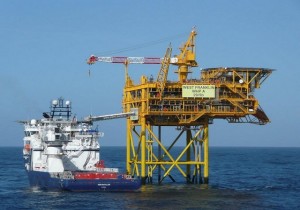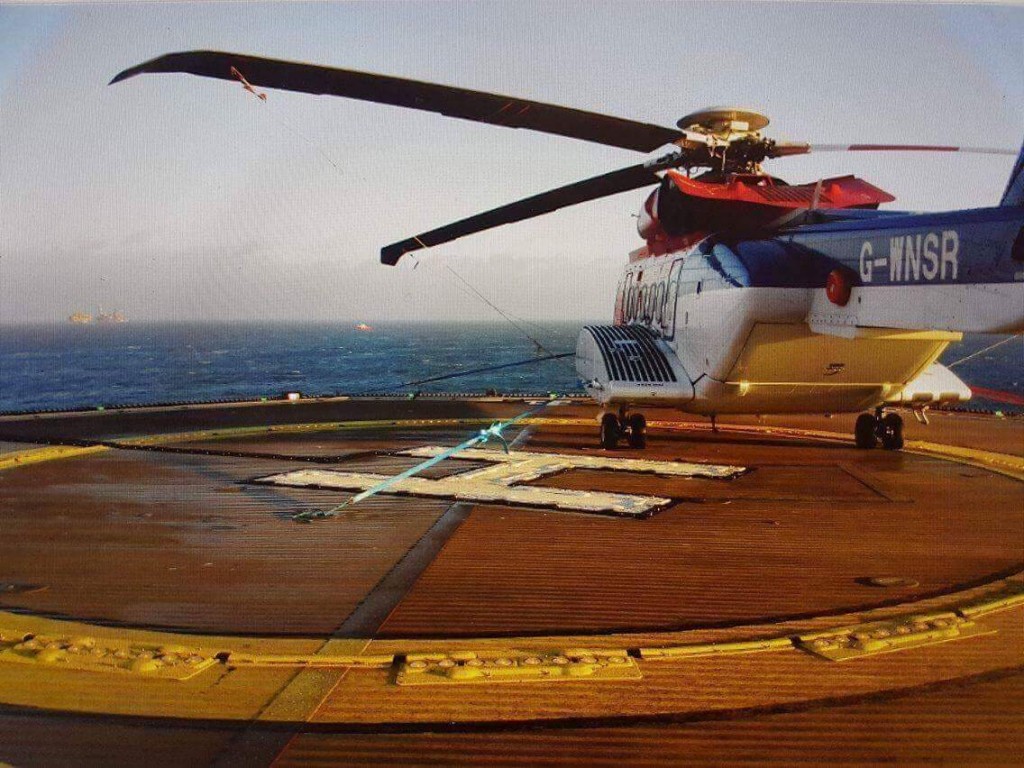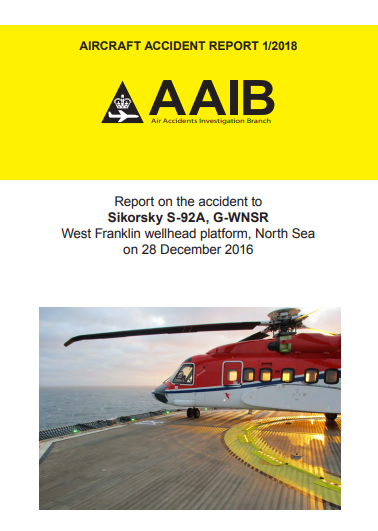Sikorsky S-92A Loss of Tail Rotor Control Events (CHC Scotia G-WNSR, Total West Franklin Installation, Central North Sea)
The UK Air Accidents Investigation Branch (AAIB) have issued a Special Bulletin on an occurrence involving Sikorsky S-92A G-WNSR of CHC Scotia on 28 December 2016, which they have classified as an Accident. This involved the failure of both the tail rotor pitch change shaft bearing and the servo piston rod itself, resulting in a total loss of tail rotor control, fortuitously without injury. We look at the background to this accident.

Severely distressed tail rotor pitch change shaft (TRPCS) double row angular contact bearing from CHC Sikorsky S-92A G-WNSR (Credit: UK AAIB)
The Accident Flight
The S-92A was on a four-sector routing from Aberdeen to Total’s Elgin-Franklin field in the Central North Sea and back as Flight 21N, which departed Aberdeen at 07:15. The second sector was from the Elgin Process Utilities Quarters (PUQ) to the West Franklin wellhead platform, 3.3 nm to the south, with 2 crew and 9 passengers on-board.

Total West Franklin WHP with a Walk 2 Work (W2W) Vessel Alongside During Commissioning (Credit: Unknown via Babcock International)
The West Franklin, whose topsides were constructed by Rosetti Marino, has a Bayards 21m, 12.8t aluminium helideck.
The meteorological observation from the Elgin PUQ at 06:08 was of a surface wind from 220° at 17 kt. The AAIB say:
As the helicopter [on a heading of 270°] lifted from the Elgin PUQ helideck it yawed unexpectedly to the right through 45°. The commander applied full left yaw pedal, checked the rotation and landed back onto the deck.
The flight crew discussed the likely cause, which they thought to have been the result of local turbulence or wind effects created by the platform structures which, anecdotally, is not uncommon for this helideck. They decided to continue and during the subsequent lift off into the hover the commander applied left yaw pedal, the helicopter responded and turned to the left; all control responses appeared normal. The commander then climbed to 500 ft for the brief transit…
The helicopter made a normal approach and deceleration to the West Franklin and crossed over the helideck. During the descent to land, at approximately 4 ft above the helideck, it yawed rapidly to the right, reaching a maximum rate of 30 degrees per second. At the same time it rolled 20° to the left, at which point the left main landing gear contacted the helideck. It continued to yaw to the right on its left mainwheels and nosewheels before the right mainwheels contacted the surface [of the helideck, causing damage to deck and the left outer main wheel rim].
The helicopter came to rest on a heading of 041° having rotated through 187°. The helicopter was shut down and the crew and passengers disembarked; there were no injuries.
CHC Sikorsky S-92A G-WNSR on the Total West Franklin Helideck – note it is not clear if this is its position immediately after the occurrence of if it had been moved to allow winching of personnel (Credit: Unknown via Energy Voice)
The helicopter was subsequently craned from the helideck onto a ship [the Ben Nevis] and recovered to Aberdeen [arriving on the morning of 30 December 2016].
Reporting
The operator transmitted a Mandatory Occurrence Report (MOR) to the UK Civil Aviation Authority (UK CAA) on 28 December 2016. It is understood that an industry lead investigation commenced promptly and the occurrence, and the damage to the helideck, was mentioned in the local press on 30 December 2016. The AAIB say they did not however become aware of it until 5 January 2017 (the same day that photographs of the damaged helideck emerged in the local press).
Investigation
Once the panels were removed it was immediately apparent that the tail rotor servo piston was damaged. The servo was removed and revealed that the tail rotor pitch change shaft (TRPCS) double row angular contact bearing was in a severely distressed condition.
Further disassembly and examination of the components found signs of severe overheating with extreme wear on the inner and outer thrust races and barrel shaped rollers of the bearing. It was found that the roller bearings seized to the inner member. The outer race roller had excessive axial play (0.5 in), such that the tail rotor driveshaft imparted a torsional load to the tail rotor servo. This torsional load caused the primary piston rod to fracture inside the servo.
Due to the failure of the primary piston, the secondary piston sleeve separated axially from the primary piston adjacent to the link fitting, with the consequential total loss of control of the tail rotor.
The components were shipped to the helicopter manufacturer for forensic analysis.
The AAIB say initial findings indicate the failure of the bearing was “rapid” but at this time they don’t quantify that.
They do say “4.5 hours had elapsed from the first exceedance of the relevant bearing condition indicator” on the Vibration Health Monitoring System (VHM) / Health and Usage Monitoring System (HUMS). They say a routine download was performed on the evening of 27 December 2016 and that a “detailed analysis of the data, conducted after the accident, showed that limit [for the Tail Gearbox Bearing Energy Analysis] had been exceeded on 27 December 2016”.
The AAIB do explain that the specific VHM system fitted, Integrated Mechanical Diagnostic HUMS (IMD-HUMS) is supplemented by some “stand-alone mechanical diagnostic software tools”. One of these is for the Tail Gearbox Bearing Energy Analysis indicator. These separate tools “require the user to visually inspect the data and search for exceedances”, whereas it is normal for HUMS to display all threshold exceedances in a single summary. However they provide no other specifics on the indications recorded, the threshold, the associated Instructions for Continued Airworthiness or the actions taken.
So at this stage of the investigation with the data released its not possible for a competent reader to draw any reliable conclusions on the VHM system performance in relation to that occurrence. Nor do the AAIB comment on oil debris monitoring.
Previous Occurrences
The AAIB do mention briefly two previous occurrences and provide minimal details. We can expand on these:
- 16 July 2007, LN-ONO of Norsk Helicopters (now part of Bristow Group): Loss of tail rotor control at top of climb resulting in a run on landing at Bergen, Norway. This occurrence resulted in Airworthiness Directive (AD) 2007-17-05 (a once off borescope inspection and a further borescope inspection 10-15 hours after installation of the pitch change servo rod and bearing) and the subsequent introduction of a stand-alone software tool to process Tail Gearbox Bearing Energy Analysis indicator.
- 28 September 2016, N923PH of PHI: Loss of tail rotor control in the hover. This occurred 1.4 hours after the installation of the TRPCS. It resulted in an Emergency Airworthiness Directive (EAD) 2016-24-51 on 18 November 2016 (and a Final Rule on 27 December 2016) on low time bearings, indicating attention on a production or overhaul error.
Both featured failures that, like G-WNSR, resulted in bearing degradation, localised heating and failure of the pitch change servo rod.
Initial AAIB Analysis
The initial findings suggest that the damage to the servo in this case is such that it could have imparted extreme or erratic inputs to the tail rotor at any time after the failure of the primary piston. Evidence suggests that the yaw which occurred on departure from the Elgin PUQ was uncommanded and may be related to the condition of the TRPCS bearing.
The AAIB considers that this failure mode would seriously affect the ability of flight crews to maintain control of the helicopter. At this early stage of the investigation the helicopter manufacturer is not clear whether this bearing degradation is the result of a new root cause, or a previously unidentified [sic: we assume ‘identified’] failure mode.
Classification
The AAIB have classified this occurrence as an Accident, rather as a Serious Incident. They say:
…this is consistent with the International Civil Aviation Organisation [Annex 13] definition as this helicopter sustained damage which adversely affected its performance and flight characteristics, and required replacement of the affected components.
Safety Actions
The AAIB say:
The operator has subsequently introduced a number of measures to further strengthen the ability to detect impending bearing degradation. These include: a review of all HUMS data to ensure no anomalies, fleet-wide borescope inspections, a requirement for HUMS to be serviceable before flight [i.e. presumably no deferrals of this parameter, in effect putting it on permanent close monitor] and the [maximum] time between HUMS download/analysis reduced to a maximum of 5 hours. The operator has also reviewed their HUMS processes and analytical procedures and introduced a requirement to carry out an additional assurance check.
On 31 December 2016 the helicopter manufacturer issued to all operators an ‘All Operators Letter’ (AOL), CCS-92-AOL-16-0019, which described the event. It emphasises the use of the HUMS Tail Gearbox Bearing Energy Tool, provided on the ground station, which will detect a TRPCS bearing that is experiencing degradation, and recommends that this Tool should be utilised as often as reasonably possible.
This was followed by an Alert Service Bulletin (ASB) issued by the manufacturer on 10 January 2017. ASB 92-64-011 introduces a one-time inspection of the TRPCS and bearing assembly for ratcheting, binding, or rough turning. The manufacturer has recommended that compliance is essential [though at this time the Federal Aviation Administration (FAA) have not issued an EAD] and is to be accomplished prior to the next flight from a maintenance facility; three flight hours are allowed in order to return directly to a maintenance facility.
The release of this ASB caused considerable media attention as it resulted in a decision to recall aircraft that were airborne and a significant temporary reduction in capacity as the inspections (which were forecast as ~11 man hours per aircraft) were conducted. This wasn’t helped by sensational headlines that implied the S-92A fleet were indefinitely grounded, which would naturally be a major workforce concern with the current unavailability of the EC225 in the UK sector. However, some ill conceived ‘deadlines’ for return the whole fleet were then generated in the media, even though local weather conditions were always going to reduce flying and hamper maintenance check flights.
More sober comments were made by HeliOffshore and by Step Change in Safety on behalf of the tripartite Offshore Helicopter Safety Leadership Group (OHSLG) created by a previously unannounced merging of CAA’s Offshore Helicopter Safety Action Group (OHSAG) and Step Change in Safety’s Helicopter Safety Steering Group (HSSG).
Additionally, the AAIB note that:
Concurrent with the release of ASB 92-64-011, the manufacturer published Temporary Revision 45-03 to require operators to use S-92 HUMS ground station software to review Tail Rotor Gearbox energy analysis Condition Indicators for alert conditions on a reduced flight hour interval. Records [we assume ‘recorded data’] in excess of published alert levels require inspection of the pitch change shaft and bearing.
We will update this article as more information enters the public domain.
UPDATE 13 January 2017: HeliOffshore have released an update from Sikorsky:
Physical inspections of the tail rotor pitch change shaft bearing are well underway with over 250 aircraft inspected. Sikorsky has been reviewing HUMS data from those aircraft as well. A small number of parts are being returned to Sikorsky for additional evaluation.
The ‘small number’ is quantified in Sikorsky CCS-92-AOL-17-0001 (to those with access). In the public domain unconfirmed reports say 4 bearings have been rejected in UK and Norway (equating to about 5% of the UK/Norwegian combined fleet).
UPDATE 14 January 2017: Late yesterday the FAA issued EAD 2017-02-51 (also available on the EASA website). It refers to three loss of control events.
This Emergency AD requires a one-time visual inspection and a repetitive borescope inspection of the TRPCS assembly bearing.
Specifically:
This Emergency AD requires, before further flight, removing the TRPCS assembly and inspecting the bearing. If the bearing does not rotate freely; the bearing sounds rough or chatters; there is any purged grease with metal particles; a nick or dent; or if there is a cut, tear, or distortion in the bearing seal, before further flight, replacing the TRPCS assembly is required. This Emergency AD also requires, within 10 hours TIS, and thereafter at intervals not to exceed 10 hours TIS, inspecting the TRPCS assembly with a borescope. If the white Teflon seal or snap ring is missing, or if there is a rip, tear, or heat damage on the seal or if there is no gap in the snap ring, replacing the TRPCS assembly is required before further flight.
Noticeably it differs from the design organisation’s ASB by introducing the repetitive borescope inspection to check the Teflon seal and snap ring (which helps contain the bearing’s grease) but it does not require the HUMS check. The FAA do not explain their logic in differing from the design organisation’s ASB however we understand its because only the main Rotor Swashplate Bearing Unit (BMU) has been certified for use, as opposed (unlike the rest of the S-92A HUMS).
UPDATE 15 January 2017: It is reported by Elan Head in Vertical Magazine that:
While S-92 flight activity dropped precipitously on Jan. 10 following issuance of the ASB, it largely rebounded within 48 hours, according to data provided by Seer Aerospace, a helicopter-focused data analytics and software company that uses ADS-B to track activity levels across the global fleet.
UPDATE 3 March 2017: Following their EAD, the FAA have issued AD 2017-02-51. This AD is open for comment until 2 May 2017.
UPDATE 20 April 2017: Taiwan AS365N3 Tail Rotor Pitch Control Loss During Hoisting
UPDATE 10 May 2017: Bell 429 TR Pitch Change Link Bearing Failure
UPDATE 4 July 2017: In Australian at least one Service Difficulty Report has been raised after temperature sensors installed have indicated above threshold:
SIKORSKY S92–ATA 6400 TAIL ROTOR SYSTEM–Temperature Indicator Plug–Turned Black. DR 611749991
During TRPCS BA 10-15 FH borescope inspection, all four temperature dots on temperature indicator plug found to have changed colour to black. Replaced tail rotor pitch change shaft and bearings.
UPDATE 16 August 2017: HeliOffshore has announced it has produced supplemental S-92A TRPCS HUMS guidance.
UPDATE 28 August 2017: Two further SDRs are raised in Australia:
SIKORSKY S92 A–ATA 6400 TAIL ROTOR SYSTEM–BEARING–OVERHEATED. DR 611750391
During post flight/daily inspection, while complying with AD 2017-05-51[e] [2] and ASB 92-64-012A, it was discovered that all 4 temperature indictor dots had been active. Further detailed reviews of the HUMS data was carried out with no indications of changes to the vibration levels. Incident was reported to Sikorsky. Suspected possible over temp’ off the tail rotor pitch change shaft bearing. Tail rotor pitch change shaft assembly has been replaced. Detailed investigation to be conducted at OEM, strip report has been requested.
SIKORSKY S92 A–ATA 6400 TAIL ROTOR SYSTEM–BEARING–OVERHEATED. DR 611750430
While carrying out inspections against AD 2017-05-51[e] [2] and ASB 92-64-012A, it was discovered that all 4 temperature indicator dots had been activated. Further detailed review of the HUMS data was carried out with no changes to the vibration levels evident. Incident was reported to Sikorsky. Further detailed inspection of the removed shaft and bearing assembly will be conducted by the OEM; a detailed strip report has been requested. Tail rotor pitch change shaft assembly has been removed, replacement serviceable assembly to be fitted after parts sourcing.
UPDATE 20 October 2017: HeliOffshore updates HUMS Best Practice Guidelines with new annexes. One of the new annexes in Version 1.1 covers the S-92A TR Pitch Change Shaft.
A subgroup under the leadership of Jason Alamond, HUMS program manager with Era Helicopters, has produced an annex defining The Ideal HUM System.
Meanwhile, another subgroup has developed a framework of key performance indicators (KPIs)… laying the groundwork for operators to be able to share and benchmark HUMS data. The HUMS KPI subgroup was led by Andy Evans, a director with Aerossurance.
UPDATE 22 December 2017: The UK AAIB confirm the report is in the ‘consultation stage’ with stakeholders.
UPDATE 22 March 2018: The AAIB issue their extensive final report.
The investigation determined that the TRPCS bearing had degraded and failed. As a consequence, the tail rotor pitch change servo was damaged resulting in uncommanded and uncontrolled inputs being made to the tail rotor (TR). The manner in which the servo was damaged had not been previously identified.
The investigation identified the following causal factors to the loss of yaw control:
● The TRPCS bearing failed for an undetermined reason.
● The TRPCS bearing failure precipitated damage to the tail rotor pitch control servo.
The investigation identified the following contributory factors:
● Impending failure of the TRPCS bearing was detected by HUMS but was not identified during routine maintenance due to human performance limitations and the design of the HUMS Ground Station (GS) Human Machine Interface (HMI).
● The HUMS GS software in use at the time had a previously-unidentified and undocumented anomaly in the way that data could be viewed by maintenance personnel. The method for viewing data recommended in the manufacturer’s user guide was not always used by maintenance personnel.
Despite being unable to determine the exact cause of the bearing failure, the helicopter manufacturer has identified and introduced a number of changes intended to reduce the risk of a recurrence including: introducing HUMS software with enhanced diagnostic capabilities and improved user interfaces, tighter control of bearing manufacturing and assembly tolerances, consistency in lubricating grease quality and its application, and in service temperature monitoring.
In this report, the AAIB makes two Safety Recommendations concerning the timeliness of acquiring, accessing, analysing and promulgating Vibration Health Monitoring (VHM) data, to enhance the usefulness of VHM data for the timely detection of an impending failure.
The S-92A has suffered one fatal rotors and transmission accident previously on 12 March 2009: Anniversary of Newfoundland S-92A Accident
UPDATE 6 August 2018: In-Flight Flying Control Failure: Indonesian Sikorsky S-76C+ PK-FUP
UPDATE 15 January 2020: AAR Bell 214ST Accident in Afghanistan in 2012: NTSB Report
UPDATE 7 February 2020: S-61N Damaged During Take Off When Swashplate Seized Due to Corrosion
UPDATE 8 January 2022: Fiery Fatal AW119 Accident in Russia After Loss of Tail Rotor Control
UPDATE 8 May 2022: HeliOffshore 2022 Conference Review
Aerossurance’s Andy Evans presented on rotor and transmission safety at the European Aviation Safety Agency (EASA) 10th Rotorcraft Symposium in Cologne in December 2016. We will be running a workshop on the topic at the CHC Safety & Quality Summit in September in Dallas.
Aerossurance was pleased to sponsor the 2017 European Society of Air Safety Investigators (ESASI) 8th Regional Seminar in Ljubljana, Slovenia on 19 and 20 April 2017. ESASI is the European chapter of the International Society of Air Safety Investigators (ISASI).






Recent Comments